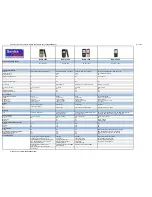
14295 Rev. 1.4 9/24/04
78
Ogo Manual
If you become aware of any abnormal phenomena, such as odor, discoloration, or
deformation, during use, while charging or when storing the battery, remove the battery
from the device or charger and stop using.
In the event the electrolyte comes into contact with the eyes, flush thoroughly with clean
water, without rubbing. Consult with a physician immediately.
18.11. RF Exposure
Tests for Specific Absorption Rate (SAR) are conducted using standard operating positions
specified by the FCC with the device transmitting at its highest certified power level in all
tested frequency bands. Although the SAR is determined at the highest certified power level,
the actual SAR level of the device while operation can be well below the maximum value.
This is because the device is designed to operate at multiple power levels so as to use only
the power required to reach the network. In general, the closer you are to a wireless base
station antenna, the lower the power output. Before a device model is available for sale to
the public, it must be tested and certified to the FCC that it does not exceed the limit
established by the government-adopted requirement for safe exposure. The tests are
performed in positions and locations (e.g., at the ear and worn on the body) as required by
the FCC for each model. (Body-worn measurements may differ among device models,
depending upon available accessories and FCC requirements). While there may be
differences between the SAR levels of various devices and at various positions, they all
meet the government requirement for safe exposure. For body worn operation, to maintain
compliance with FCC RF exposure guidelines, use only accessories that contain no metallic
components and provide a separation distance of 1.5cm (0.6 inches) to the body. Use of
other accessories may violate FCC RF exposure guidelines and should be avoided.
18.12. Health and Safety Information
18.12.1. Exposure to Radio Frequency (RF) Signals
Your wireless device is a radio transmitter and receiver. It is designed and manufactured not
to exceed the emission limits for exposure to radio frequency (RF) energy set by the Federal
Communications Commission of the U.S. Government. These limits are part of
comprehensive guidelines and establish permitted levels of RF energy for the general
population. The guidelines are based on the safety standards previously set by both U.S.
and international standards bodies:
American National Standards Institute (ANSI) IEEE. C95.1-1992
National Council on Radiation Protection and Measurement (NCRP). Report 86.1986.
International Commission on Non-Ionizing Radiation Protection (ICNIRP) 1996.
Ministry of Health (Canada), Safety Code 6. The standards include a substantial safety
margin designed to assure the safety of all persons, regardless of age and health.
The exposure standard for wireless mobile devices employs a unit of measurement
known as the Specific Absorption Rate, or SAR. The SAR limit set by the FCC is
1.6W/kg*.
Содержание AT&T Ogo
Страница 1: ......



























